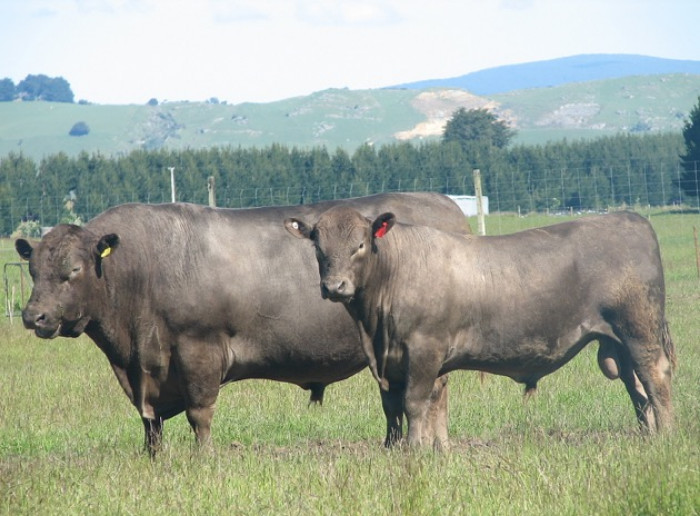Bull burps could hold answer to climate friendly cows
Rowan Schindler
17 May 2021, 4:53 PM
 A pilot trial which measures a bull’s burps has found a possible link between a bull’s genetics and the amount of methane it produces. Image: Pixabay.
A pilot trial which measures a bull’s burps has found a possible link between a bull’s genetics and the amount of methane it produces. Image: Pixabay. The opportunity to breed more climate friendly cows is one step closer for New Zealand dairy farmers after a Waikato trial finds a possible link between a bull’s genetics and the amount of methane they produce.
The pilot trial, by artificial breeding companies LIC and CRV with funding from the New Zealand Agricultural Greenhouse Gas Research Centre, measured feed intake and methane emissions – in the form of burps – from 20 young bulls destined to father the next generation of New Zealand’s dairy cows.
The levels of methane produced by cattle farming is often a heavy criticism of the industry.
LIC Chief Scientist Richard Spelman says results from the pilot trial are promising.
“Methane production primarily relates to how much an animal eats,” Richard says.
“We’ve accounted for this and we’re still seeing variation which suggests genetics plays a role in a dairy bull’s methane emissions – now we need more data to prove it.”
The research will now progress to a much larger study where operations have scaled up to collect measurements from 300 young bulls, the full intake from LIC and CRV’s Sire Proving Scheme.
“If this genetic link is confirmed, farmers will ultimately be able to breed low methane-emitting cows from low methane-emitting bulls.”
Agriculture Minister Damien O’Connor attended the launch of the project at LIC’s farm outside of Hamilton.
“What makes me so excited about this project is the cooperation. A company from the Northern Hemisphere and a company from the Southern Hemisphere working together for a common objective.
“There are lots of options for methane emission reduction being looked at, and this is a great one,” Damien O’Connor says.
“Each one of the cows we have in New Zealand now produces a whole lot more for the same inputs that we put in maybe 20 or 30 years ago.
“That kind of progressive development that we’ve seen in production, we want to now see in methane reduction and I’m sure we can do that. We are innovative, we’re creative and we’re cooperative.”

Bull burps are being used to measure the amount of methane produced by bulls in order to identify the genetic strains desirable for breeding lower-methane producing cattle. Image: Pixabay.
Although methane emissions have been shown to be heritable, Richard says LIC and CRV will carry out additional research to validate their findings.
“We will be methane testing daughters from the bulls that are identified to be high or low methane emitters to check their emissions are representative of their father’s.
“It’s a long term project but it has the potential to deliver real benefits to farmers in the future by providing another tool to reduce their farm emissions,” Richard says.
CRV R&D Manager Phil Beatson says more than two and a half years of planning together with his colleagues at LIC has gone into setting up a robust structure for the research project.
“Together, we have done a significant amount of work to set up this trial, including using insights from overseas projects measuring feed intake and methane emissions.
“We believe we are using the best approach for what is enormously complicated work.
“CRV and LIC recognise that environmental issues have become increasingly important to New Zealand agriculture.
“Our collaboration, with support from MPI, AgResearch and NZAGRC, demonstrates our commitment to keep finding genetic solutions that can help farmers future-proof their business.”
Harry Clark, Director of the New Zealand Agricultural Greenhouse Gas Research Centre, is delighted with the outcomes of the pilot trial.
“We have been highly successful in New Zealand in breeding low-emitting sheep and this preliminary work with the bulls is a positive sign that we should be able to achieve the same for the dairy sector,” Harry says.
Richard says while breeding for more climate friendly cows is the focus, it’s still a balancing act with other genetic traits.
“It’s really important that we understand the genetic relationships between methane and traits like milk production and fertility.
“We don’t want to find we are selecting against methane and inadvertently breeding cows that are less fertile.”
The trial is being run by Livestock Improvement Corporation (LIC) and CRV, which together sire 90% of the New Zealand dairy herd through their artificial breeding bulls.
The project has received funding from the New Zealand Agricultural Greenhouse Gas Research Centre (NZAGRC).
The bulls involved in the trial are housed in a barn so their feed intake can be measured.
Bulls help themselves to feed throughout the day. They eat Lucerne hay cubes via feed bins which measures how much each bull eats.
The bulls independently visit the Greenfeed machine - a special methane measuring device.
They’re enticed to visit the machine as they get a small feed of pellets which keeps them in the machine for three to five minutes – enough time to get a methane measurement (ruminant animals burp every 1-2 mins).
Bulls are under 24/7 video surveillance so scientists can monitor them remotely. It also allows scientists the ability to go back and review footage if they see any odd pieces of data from the machines that need further explanation.
The welfare of the bulls taking part in the trial is being constantly monitored by LIC, with oversight from the Ruakura Ethics Committee which has approved the project.
The bulls have the freedom to move around in their pens; eat, drink and sleep when they wish.
Advertisement



